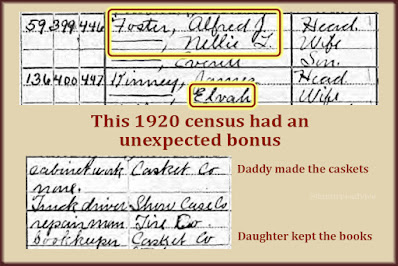Does your family tree ever weigh you down? Here's an easy way to push ahead without getting burned out.
I've been off to the races on my 2019 Genealogy Goals. I completed my 1st goal by mid-January. Now I'm making a serious push on my 2nd goal.
 |
| I've finished my 1st genealogy goal of the year, but the 2nd one can get tedious. |
I'm excited about how many census forms I've added to my family tree in a short time. Fifty-five in 2 weeks!
But sometimes I get bored. I'll find a census for a big family and think, "Now I've got to add all these facts to all these people." I don't want to stop working on my tree. But it can feel like a grind sometimes.
What's a bored genealogist to do?
Try a New Strategy
I've been using an anti-boredom strategy since I was a girl. I still use it when I'm cleaning the house, shoveling snow, or working at my day job.
The secret is this: Jump from small task to small task and trick your brain into thinking you're on to something new.
For example, when I mow the lawn, I tend to shift directions. Carve out a smaller section to cut. I'm purposely not committing myself to an enormous job. I'm committing to one piece of the job at a time. I'm telling myself I can stop whenever I want to. Then I realize I want to do another section. I go on to complete the larger task, one piece at a time.
Why not apply this strategy to genealogy?
I still encourage you to keep a list of genealogy goals—even if you won't complete them this year. But, to battle any boredom, keep a separate, smaller task list. These tasks are the things you can jump to when your bigger goal is bogging you down.
Last night I was getting discouraged with one family because I couldn't find them in 1910 or 1930. I tried all kinds of search tricks, but they kept hiding from me.
That's when I noticed a problem with some of the images in my family tree. They were missing a date or category, or weren't named in my usual style. I'd detached a few unwanted images, but I'd forgotten to delete them.
I overcame my boredom and frustration by fixing the problems with these 30-something images. It was a mental break. A short, easy task. And I'm so happy they're fixed.
I pressed on and edited the captions for all my photos of grave markers. I wanted them to be consistent, and I could never decide if they were tombstones, gravestones, headstones, or what. So I chose "grave marker" and labelled each photo in the same way. I put the cemetery name in the description. If I had the original URL for the image, I made sure each one said "From the Find-a-Grave website" followed by the URL.
 |
| Cleaning up a certain file type in my family tree was a quick break to get me back on track. |
I keep a list of smaller genealogy tasks I want to finish. They're not lofty enough to be on my annual goals list, so I called them my "Rainy-Day Genealogy List". I could call them my "I'm Bored List":
- Transcribe my Oct 2018 interview of Mom and Dad (should take an hour or so)
- Sort out my photo collection, scan the non-digitized ones, and add more to my tree (a weekend job)
- Capture all entries from my old notebook of Ellis Island immigrants (I don't have to do it all at once)
- Revisit my brother's old genealogy paper for more facts from Grandpa (a couple of hours, tops)
- File away everything in my catch-all "gen docs" folder (a bigger task, but easy to break into pieces)
It's Time to Start Your List
You must have similar tasks you'd like to complete. Start your list of boredom busters. Choose one as a mental break when you feel frustrated by a brick wall.
Don't avoid genealogy because one family is driving you crazy. Move on to something simpler for a while. Something you can finish with no obstacles.
Break through that boredom while making your end-product better and better. Your family tree is going to be the tidiest family tree in the neighborhood!



